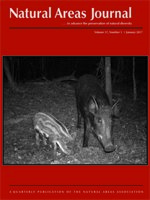The mesosphytic forests of eastern North America represent a forest region characterized by dramatic 20th century changes in disturbance regimes, notably the exclusion of fire. Tree-ring reconstructions of forest disturbance can inform restoration and management plans by placing these changes into a historical context. This study examined forest disturbance with regard to land use change and drought in the New River Gorge region of West Virginia. I developed a 182-year pitch pine (Pinus rigida) growth chronology (1833–2014) using samples collected from 33 trees along 2 km of southand southwest-facing slopes at Babcock State Park. Samples cut from fire-scarred pitch and Virginia pine (Pinus virginiana) were used to generate a fire chronology for the site. Temporal trends in pitch pine growth variability were assessed using regime shift and growth release detection methods. There was no change in pitch pine growth during the transition from the early settlement to industrial era (ca. 1885), while a significant decrease in annual growth variability characterized the post-industrial era (1963–2014). Seventeen fire events were recorded between 1887 and 1968. Growth releases displayed a temporal relationship with fire and there was a strong, but not significant, association between drought and fire years. These results suggest a coupled system in which anthropogenic fires driven by periodic drought maintained pitch pine before and during industrialization. Reintroducing fire to the post-industrial forest may not meet management objectives as decades of fire exclusion have altered forest fuels and species composition such that its effects would be difficult to predict.
How to translate text using browser tools
1 January 2017
Forest Disturbance History from ‘Legacy’ Pitch Pine (Pinus rigida) at the New River Gorge, West Virginia
Thomas Saladyga

Natural Areas Journal
Vol. 37 • No. 1
January 2017
Vol. 37 • No. 1
January 2017
Central Appalachians
dendrochronology
fire history
Fire management
Pinus rigida




